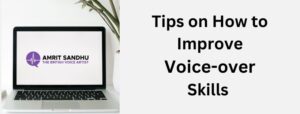In today’s multiplatform world, voice-over is a versatile and in-demand ability. Learning voice-over methods can open up a world of opportunity, whether your goal is to become a professional voice artist, develop your public speaking talents, or simply wish to better your communication ability.
In this blog, we’ll look at twelve (12) of the best voice-over techniques that can elevate your performances to the next level and you can use to captivate your audience and leave a lasting impact.
Articulation and Diction
For voice-over work, clear articulation and appropriate diction are essential. To prevent slurring or mumbling, make sure to pronounce each phrase clearly and to polish your consonants and vowels. Make sure to pronounce every syllable loudly and clearly. Aim for a moderate, natural tone because over pronunciation can be just as damaging as muttering. Tongue twisters are a great exercise for improving your articulation.
Breath Control and Projection
Breath control and projection are two essential components of good voice-over work. To maintain a continuous flow of air while speaking and improve the overall sound and sustain of your voice, practice controlled exhaling. Using the right breathing techniques will help you keep your voice steady, prevent breathy sounds, and make sure that it can be heard by everyone in the room. Use your diaphragm to take deep breaths, which will help you speak in lengthier sentences without wearing out your vocal cords. You can improve your breath capacity and control, which is necessary for a sustained, forceful delivery, by engaging in deep diaphragmatic breathing exercises.
Character Development
Spend time creating your character if you’re doing voice-over work that is character-driven. Make up a backstory for them, learn why they do what they do, and become fully immersed in their world. Your performance will be more genuine the more you relate to the role.
Microphone Technique
For any voice actor, being able to utilize a microphone successfully is a crucial skill. To prevent distortion or clipping, choose the ideal distance to keep from the microphone. Try several microphone placements and angles to discover the one that best matches the natural nuances of your speech and improves the sound quality overall.
Range and Expression of Emotions
The ability to depict a variety of emotions is frequently necessary for voice acting. Work on your emotional expressiveness and range if you want to succeed in this area. Try practicing saying lines with a range of emotions—from exhilaration to sadness—and try to make your audience experience those emotions through your voice.
Tone and Emotion
It’s essential to learn the necessary emotional nuances and tone required by the screenplay in order to provide an engaging and appealing voice-over. To effectively depict the emotion, whether it be excitement, enthusiasm, or melancholy, you must comprehend the context and purpose of each phrase. During practice, experimenting with various emotions might assist you in building a broad repertory.
Pacing and Timing
In order to achieve a natural rhythm and flow within the screenplay, mastering pacing and time is crucial when working on voice-overs. To strike the proper balance and keep the audience interested, try out various pacing, pausing, and accentuating techniques. An effective voice-over performance depends on good timing and tempo. The natural rhythm and flow of the script should be observed. Adapt your speed to the scene by slowing down during emotional parts and accelerating during action ones, for example. Always keep in mind that humor and suspense depend heavily on timing.
Script Analysis
Spend some time reading through the script in detail before recording. Recognize the history and intentions of the persona or brand you are portraying. Your performance will be more compelling and authentic as a result of this understanding.
Versatility
A voice actor’s versatility opens up a world of opportunities. To show off your versatility and broaden your range, practice using various accents, character voices, and articulations. In the industry, it is highly regarded to be able to switch between diverse voiceover requirements with ease.
Vocal Warm-ups
Just like with any other physical exercise, it’s important to warm up your vocal cords before a recording session. To relax your vocal muscles and improve your range and flexibility, practice vocal exercises like lip trills, tongue twisters, and humming.
Editing and Post-Production Skills
Nowadays, recording and editing your own work is a common part of voice-over. Learn how to edit audio to reduce background noise, improve audio quality, and clean up recordings. You can become a more marketable and independent voice actor by learning these abilities.
Consistent Practice and Seeking Feedback
Lastly, always keep in mind that practice makes perfect. You may improve your voice-over abilities by practicing frequently and asking for comments from peers or industry experts. Join online networks for voice actors, enroll in courses, and never stop improving your art.
It takes time, effort, and devotion to constant progress to master voice-over techniques. These techniques will enable you to give engaging and memorable voice-over performances, regardless of whether you want to pursue a profession in voice acting or are just looking to improve your communication abilities. As a result, if you continue to practice, learn new things, and improve your skills, you’ll find that your voice starts to become a useful tool and will shine in the voice-over industry.




